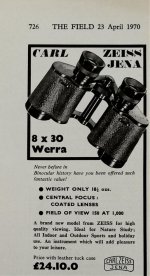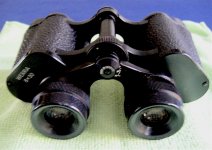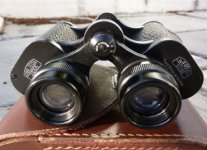Hi,
I like to search out and collect buy/sell vintage Porro's and recently bought a Leitz Binuxit to restore, at the same time I noticed an absolutely mint condition 8X30 made by WERRA, it has Germany on it as well. I had no idea about it but it was not much money, so I just bought it. I have tried to find out a bit about it, and it seems to be rumored to have been made by Zeiss at a factory near the river WERRA wherever that is. I am doubtful of this as the optical quality is nowhere near as good as a Jenoptem, and although similar in appearance, the objective beauty rings are sort of squared off rather than beveled. Be grateful if anyone has any info on these?
Speaking of Jenoptems, I have 2 pairs, both genuine, 8x30, both made in the 80s, both mint, clean inside, no fog,fungus or dust, both aligned ok (checked) but one of them is definitely sharper than the other when viewing. You would be happy with either if you did not know, but knowing is puzzling and irritating, but expect one will be going on ebay soon, wonder which??.
I like to search out and collect buy/sell vintage Porro's and recently bought a Leitz Binuxit to restore, at the same time I noticed an absolutely mint condition 8X30 made by WERRA, it has Germany on it as well. I had no idea about it but it was not much money, so I just bought it. I have tried to find out a bit about it, and it seems to be rumored to have been made by Zeiss at a factory near the river WERRA wherever that is. I am doubtful of this as the optical quality is nowhere near as good as a Jenoptem, and although similar in appearance, the objective beauty rings are sort of squared off rather than beveled. Be grateful if anyone has any info on these?
Speaking of Jenoptems, I have 2 pairs, both genuine, 8x30, both made in the 80s, both mint, clean inside, no fog,fungus or dust, both aligned ok (checked) but one of them is definitely sharper than the other when viewing. You would be happy with either if you did not know, but knowing is puzzling and irritating, but expect one will be going on ebay soon, wonder which??.








